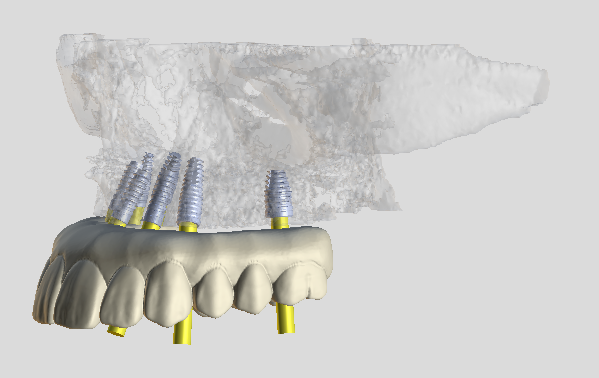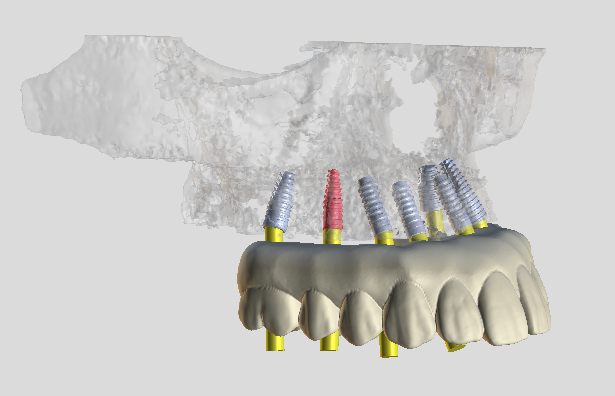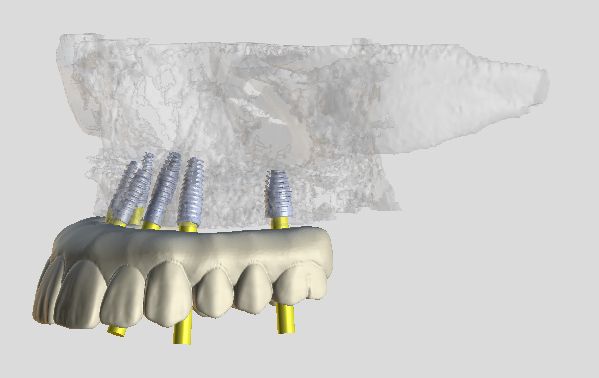Dental Implant Specialists
Having received extensive training in dental implantology, Barr Periodontics & Implants, VA, continue to pursue their education on the latest advancements in implant dentistry. Successfully restoring the smiles of our patients, we also instruct them on the practices of maintaining a healthy dental hygiene routine. Brushing, flossing, and maintaining regular dental visits make for complete, long-lasting care. To learn more about if dental implants are right for you, call us at
(757) 422-0005 or
(757) 548-2553.
Dental Implant Specialists
Having received extensive training in dental implantology, Barr Periodontics & Implants, VA, continue to pursue their education on the latest advancements in implant dentistry. Successfully restoring the smiles of our patients, we also instruct them on the practices of maintaining a healthy dental hygiene routine. Brushing, flossing, and maintaining regular dental visits make for complete, long-lasting care. To learn more about if dental implants are right for you, call us at
(757) 422-0005 or
(757) 548-2553.
What are Dental Implants?
Dental implants are small titanium posts that are surgically placed into the jawbone. These metal posts bond with the bone and become a steadfast anchor for the replacement tooth. The artificial teeth are attached to sections extending from the gums. Preserving the facial structure, dental implants prevent the bone deterioration and muscle sagging that comes with missing teeth. Dental implants can be a permanent solution for missing teeth providing patients with a beautiful and healthy smile!
What are Dental Implants?
Dental implants are small titanium posts that are surgically placed into the jawbone. These metal posts bond with the bone and become a steadfast anchor for the replacement tooth. The artificial teeth are attached to sections extending from the gums. Preserving the facial structure, dental implants prevent the bone deterioration and muscle sagging that comes with missing teeth. Dental implants can be a permanent solution for missing teeth providing patients with a beautiful and healthy smile!
Dental Implant Evaluation & Consultation
Consulting with Barr Periodontics & Implants will help you determine if dental implants are the right choice for you. During a dental evaluation, a 3-D cone beam CAT scan will ascertain the quality of your bone. Considering your specific needs, the doctors will develop a treatment plan to ensure you get the best results possible.
Each item of your diagnosis will be itemized and fully explained. As part of the evaluation, you will be informed of all costs involved in advance and the estimation of insurance benefits, should you have any. Our doctors are always available to answer your questions and address your concerns.

Single Tooth Replacement
A dentist will perform the initial dental implant examination and consultation and will take one or more X-rays of the area to prepare for the procedure. Barr Periodontics & Implants will develop a treatment plan and models for your dental implant will be made.
- A single prosthesis (crown) replaces one missing tooth. Each prosthetic tooth will attach to its dental implant.
- After the procedure, the implant can heal for a few months to fuse with the jawbone before the next step is taken.
- After healing, the final step is to make another mold of the teeth, followed by the placement of the permanent ceramic tooth.
- The result is a substitution of a natural tooth. Afterward, regular maintenance should be performed every six months to keep the tooth and gum around it clean and healthy.
Bone Grafting
In some cases, a bone graft is necessary to increase an area of the gum to support dental implants. This procedure utilizes the patient’s bone, a synthetic source of the bone, or a bone from the bone bank to develop a portion of the jaw. This will make up for sections of missing bone that could have been lost by trauma or gum disease.
During this procedure, a special membrane can protect the grafted area and encourage the bone’s regeneration. After the bone has been augmented, the area is ready to receive dental implants. This procedure is necessary to ensure a fully functional and cosmetic replacement for missing teeth.
Immediate, Temporary Dental Implants
Using the latest developments in dental implantology, it is now possible to place in a temporary dental implant on the same day as an extraction of a tooth. A temporary fabricated replacement is used so you won’t have to wear removable restoration prostheses for 3 to 4 months. We can use an existing crown or fabricate a composite restoration which we place on a temporary abutment. This procedure can be done in-office, or the fabrication of the temporary restoration can be done by a general dentist. After healing, the provisional restoration is taken out and an impression is made. This approach develops an ideal emergence profile for the final restoration.
Multiple Dental Implants
- The new bridge will perform as the original back row teeth did. The new implant crowns will be stable and secure enough so the patient can chew and eat whatever they desire.
- The multiple dental implants must fuse with the jawbone before the permanent bridge can be attached. Another mold of your teeth will be made, followed by the placement of the permanent bridge.
- The dental implants are carefully placed, secured, and allowed to heal for approximately 3 to 6 months.
- A partial prosthesis (fixed bridge) can replace two or more teeth and may require only two or three implants. In this example, 3 teeth in the back area of the mouth are missing. The only replacement alternative is placing a partial plate. Implants will avoid a plate that needs to be removed daily. Treatment plans will be developed. If there is bone loss, grafting may be performed before implant placement.
Dental Implant Evaluation & Consultation
Consulting with Barr Periodontics & Implants will help you determine if dental implants are the right choice for you. During a dental evaluation, a 3-D cone beam CAT scan will ascertain the quality of your bone. Considering your specific needs, the doctors will develop a treatment plan to ensure you get the best results possible.
Each item of your diagnosis will be itemized and fully explained. As part of the evaluation, you will be informed of all costs involved in advance and the estimation of insurance benefits, should you have any. Our doctors are always available to answer your questions and address your concerns.

Single Tooth Replacement
A dentist will perform the initial dental implant examination and consultation and will take one or more X-rays of the area to prepare for the procedure. Periodontists and restorative dentists, Barr Periodontics & Implants will develop a treatment plan and models for your dental implant will be made.
- A single prosthesis (crown) replaces one missing tooth. Each prosthetic tooth will attach to its dental implant.
- After the procedure, the implant can heal for a few months to fuse with the jawbone before the next step is taken.
- After healing, the final step is to make another mold of the teeth, followed by the placement of the permanent ceramic tooth.
- The result is a substitution of a natural tooth. Afterward, regular maintenance should be performed every six months to keep the tooth and gum around it clean and healthy.
Bone Grafting
In some cases, a bone graft is necessary to increase an area of the gum to support dental implants. This procedure utilizes the patient’s bone, a synthetic source of the bone, or a bone from the bone bank to develop a portion of the jaw. This will make up for sections of missing bone that could have been lost by trauma or gum disease.
During this procedure, a special membrane can protect the grafted area and encourage the bone’s regeneration. After the bone has been augmented, the area is ready to receive dental implants. This procedure is necessary to ensure a fully functional and cosmetic replacement for missing teeth.
Immediate, Temporary Dental Implants
Using the latest developments in dental implantology, it is now possible to place in a temporary dental implant on the same day as an extraction of a tooth. A temporary fabricated replacement is used so you won’t have to wear removable restoration prostheses for 3 to 4 months. We can use an existing crown or fabricate a composite restoration which we place on a temporary abutment. This procedure can be done in-office, or the fabrication of the temporary restoration can be done by a general dentist. After healing, the provisional restoration is taken out and an impression is made. This approach develops an ideal emergence profile for the final restoration.
Multiple Dental Implants
- The new bridge will perform as the original back row teeth did. The new implant crowns will be stable and secure enough so the patient can chew and eat whatever they desire.
- The multiple dental implants must fuse with the jawbone before the permanent bridge can be attached. Another mold of your teeth will be made, followed by the placement of the permanent bridge.
- The dental implants are carefully placed, secured, and allowed to heal for approximately 3 to 6 months.
- A partial prosthesis (fixed bridge) can replace two or more teeth and may require only two or three implants. In this example, 3 teeth in the back area of the mouth are missing. The only replacement alternative is placing a partial plate. Implants will avoid a plate that needs to be removed daily. Treatment plans will be developed. If there is bone loss, grafting may be performed before implant placement.
Non- Removable Partial Dentures
A complete dental prosthesis (fixed bridge) replaces all the teeth in your upper or lower jaw. The number of implants varies depending on which type of prosthesis (removable or fixed) is recommended.
- Patient comes to us with dentures or missing/hopeless teeth and wants dental implants – non-removable partial dentures. Treatment planning is performed, molds are made, and if additional bone or gum tissue is needed, those procedures are planned for.
- Several implants will be necessary to support a fixed denture. During the healing process, temporary tooth replacements can be fabricated and used. Usually, this process is coordinated with your dentist and periodontist.
- After healing, the final bridge or denture is securely attached on top of the implants. With a full jaw replacement like this, it normally takes 2-3 visits to have the bridge completely attached, which is now non-removable by the patient.
- Your new teeth or dentures will fit better than your old dentures and allow you to talk and eat with more confidence.
Preserving the Tooth Side
Implant site preservation for prudent management of an extraction socket following the removal of a tooth will help lessen the reduction of bone loss and lend a preferable cosmetic outcome for tooth replacement. Bone grafting is a process that will preserve the socket/ridge after a tooth extraction, minimizing gum and bone collapse. With less gum shrinkage, there is a more esthetic area for an implant crown or fixed bridge around the replacement teeth.
Removable Partial Dentures
- A removable prosthesis (overdenture) attaches to a bar or ball in socket attachments, whereas a fixed one is permanent and removable only by the dentist.
- The patient comes to us with dentures and wants implants. Treatment planning is performed, molds are made, and if additional bone or gum is needed, those procedures are planned for.
- Once the implants are placed and allowed to heal, a removable full denture can be connected to either a ball or bar attachment. The implants help keep the denture in place and provide better function and comfort.
Non- Removable Partial Dentures
A complete dental prosthesis (fixed bridge) replaces all the teeth in your upper or lower jaw. The number of implants varies depending on which type of prosthesis (removable or fixed) is recommended.
- Patient comes to us with dentures or missing/hopeless teeth and wants dental implants – non-removable partial dentures. Treatment planning is performed, molds are made, and if additional bone or gum tissue is needed, those procedures are planned for.
- Several implants will be necessary to support a fixed denture. During the healing process, temporary tooth replacements can be fabricated and used. Usually, this process is coordinated with your dentist and periodontist.
- After healing, the final bridge or denture is securely attached on top of the implants. With a full jaw replacement like this, it normally takes 2-3 visits to have the bridge completely attached, which is now non-removable by the patient.
- Your new teeth or dentures will fit better than your old dentures and allow you to talk and eat with more confidence.
Preserving the Tooth Side
Implant site preservation for prudent management of an extraction socket following the removal of a tooth will help lessen the reduction of bone loss and lend a preferable cosmetic outcome for tooth replacement. Bone grafting is a process that will preserve the socket/ridge after a tooth extraction, minimizing gum and bone collapse. With less gum shrinkage, there is a more esthetic area for an implant crown or fixed bridge around the replacement teeth.
Removable Partial Dentures
- A removable prosthesis (overdenture) attaches to a bar or ball in socket attachments, whereas a fixed one is permanent and removable only by the dentist.
- The patient comes to us with dentures and wants implants. Treatment planning is performed, molds are made, and if additional bone or gum is needed, those procedures are planned for.
- Once the implants are placed and allowed to heal, a removable full denture can be connected to either a ball or bar attachment. The implants help keep the denture in place and provide better function and comfort.
Ridge Expansion Procedure
The ridge bone supports the area around your teeth. When a tooth is removed, the empty space left from the tooth begins to collapse. The ridge deteriorates and narrows down to a point too small to allow for dental implants to be used. The height of the ridge can also recede. To ensure the use of implants, the ridge bone must be treated by an oral surgeon.
Making a Wider Ridge for Dental Implants
The ridge expansion procedure enlarges the ridge by dividing the inner and outer sections of the bone and filling it in with bone-graft. The bone graft material matures over a few months before it is ready for implantology. The result is a thickened ridge that will support a dental implant to be inserted to replace the lost tooth.
Our oral surgeons are highly experienced and are experts in treating bone deterioration. When consulting with us, we will address your questions and concerns regarding your options and make recommendations for an effective procedure.
Ridge Expansion Procedure
The ridge bone supports the area around your teeth. When a tooth is removed, the empty space left from the tooth begins to collapse. The ridge deteriorates and narrows down to a point too small to allow for dental implants to be used. The height of the ridge can also recede. To ensure the use of implants, the ridge bone must be treated by an oral surgeon.
Making a Wider Ridge for Dental Implants
The ridge expansion procedure enlarges the ridge by dividing the inner and outer sections of the bone and filling it in with bone-graft. The bone graft material matures over a few months before it is ready for implantology. The result is a thickened ridge that will support a dental implant to be inserted to replace the lost tooth.
Our oral surgeons are highly experienced and are experts in treating bone deterioration. When consulting with us, we will address your questions and concerns regarding your options and make recommendations for an effective procedure.
Sinus Lift Procedure
The maxillary sinuses are located above the roots of the upper teeth. When these upper teeth are removed, there is often just a thin wall of bone separating the maxillary sinus and the mouth. Dental implants need bone for anchorage to provide stability. Therefore, if the sinus is in the future implant site, one or two types of sinus lift procedures will be necessary.
Inferior Sinus Lift Procedure
If there is enough bone present between the upper jaw ridge and the bottom of the sinus to stabilize the implant, sinus augmentation and implant placement can sometimes be performed as a single procedure called an inferior sinus lift. If there is not enough bone available, a lateral sinus augmentation would be performed first, followed by a graft which would be left to mature for a few months. Accessing the sinus where the upper teeth used to be, the periodontist lifts the sinus membrane upward.
In the space made by lifting the sinus membrane, the periodontist places in the donor bone. After several months of healing, the donor bone fuses, becoming the new sinus bone. The patient’s jaw will now allow for dental implants to be inserted. During the healing stage, the patient wears a temporary denture to resume eating a regular diet. Most patients will not experience any disruption in their daily routine. Thanks to the sinus graft, patients now have the option to use dental implants, while only a few years ago had no choice but to wear dentures.
Sinus Lift Procedure
The maxillary sinuses are located above the roots of the upper teeth. When these upper teeth are removed, there is often just a thin wall of bone separating the maxillary sinus and the mouth. Dental implants need bone for anchorage to provide stability. Therefore, if the sinus is in the future implant site, one or two types of sinus lift procedures will be necessary.
Inferior Sinus Lift Procedure
If there is enough bone present between the upper jaw ridge and the bottom of the sinus to stabilize the implant, sinus augmentation and implant placement can sometimes be performed as a single procedure called an inferior sinus lift. If there is not enough bone available, a lateral sinus augmentation would be performed first, followed by a graft which would be left to mature for a few months. Accessing the sinus where the upper teeth used to be, the periodontist lifts the sinus membrane upward.
In the space made by lifting the sinus membrane, the periodontist places in the donor bone. After several months of healing, the donor bone fuses, becoming the new sinus bone. The patient’s jaw will now allow for dental implants to be inserted. During the healing stage, the patient wears a temporary denture to resume eating a regular diet. Most patients will not experience any disruption in their daily routine. Thanks to the sinus graft, patients now have the option to use dental implants, while only a few years ago had no choice but to wear dentures.
Call (752) 422-0005 or (757) 548-2553 to learn more about dental implants.
Call (757) 422-0005 or (757) 548-2553 to learn more about dental implants.



